Warren Cup
| Part of the boylove history series |
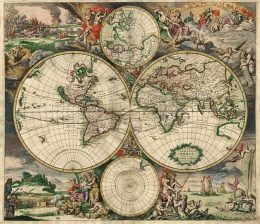 |
| Portal:History |
"The Warren Cup is an ancient Roman silver drinking cup decorated in relief with two images of male (Pederastic) same-sex acts. The cup is named after its first modern owner, the collector and writer Edward Perry Warren, and was acquired by the British Museum in 1999 for the sum of 1.8 million pounds. It is usually dated to the time of the Julio-Claudian dynasty (1st century AD). It was bought in Jerusalem and said to have been found near the city in Battir[1] (ancient Bethther), with coins of the emperor Claudius, possibly buried during the upheavals of the Jewish Revolt. According to the British Museum Director:[1]
We don't know for certain, but it's thought that the Warren Cup was found buried at Bittir, a town a few miles south-west of Jerusalem. How it got to this location is a mystery, but we can make a guess. We can date the making of the cup to around the year 10. About 50 years later, the Roman occupation of Jerusalem sparked tensions between the rulers and the Jewish community, and in AD 66 that exploded and the Jews took back the city by force. There were violent confrontations, and it is thought that our cup may have been buried at this date by the owner fleeing from the fighting.
- (Note: Due to the current moral panic in The United Kingdom, claims against the Warren Cup’s authenticity should be considered as suspect and possibly being revisionist as well as based on political motivations.) [2]
Imagery
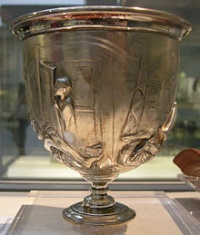
|
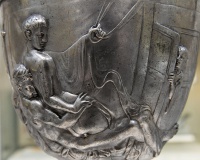
|
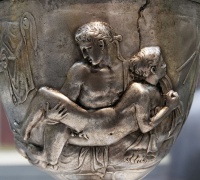
|
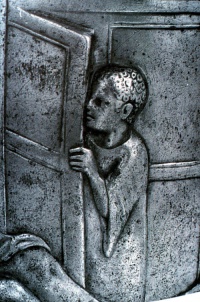
|
The Warren Cup is a piece of convivial silver, usually dated to the time of the Julio-Claudian dynasty (1st century AD), that depicts two scenes of male-male sex.[3] It has been argued[4] that the two sides of this cup represent the duality of pederastic tradition at Rome, the Greek in contrast to the Roman. On the "Greek" side, a bearded, mature man is mounted by a young but muscularly developed male in a rear-entry position. The young man, probably meant to be 17 or 18, holds on to a sexual apparatus for maintaining an otherwise awkward or uncomfortable sexual position. A child-slave watches the scene furtively through a door ajar. The "Roman" side of the cup shows a puer delicatus, age 12 to 13, held for intercourse in the arms of an older male, clean-shaven and fit. The bearded pederast may be Greek, with a partner who participates more freely and with a look of pleasure. His counterpart, who has a more severe haircut, appears to be Roman, and thus uses a slave boy; the myrtle wreath he wears symbolizes his role as an "erotic conqueror".[5] The cup may have been designed as a conversation piece to provoke the kind of dialogue on ideals of love and sex that took place at a Greek symposium.[6][7]
Dating and authenticity
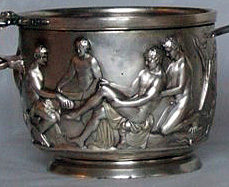
John R. Clarke, Professor in Fine Arts at the University of Texas at Austin, has approximated the dating of the cup with similarly styled objects found in Pompeii, due to the lack of archaeological context.[9]
Dyfri Williams, previously the Keeper of Greek and Roman Antiquities at the British Museum, dated the cup to AD 5–15. Williams identified several factors supporting that dating. The silver alloy being 95% pure is consistent with other known Roman silver vessels, with silver from later periods having a far higher purity. Cracks in the cup retain chemical corrosion products which are symptomatic of age, remaining despite being cleaned twice during the 20th century.[10] An Energy-dispersive X-ray spectroscopy analysis showed that the corrosion was silver chloride.[11] Subsequent testing in 2015 of the inside repoussé shelf and the reverse of the liner, neither of which had been cleaned, found substantial silver chloride corrosion.[12] The decorative style and shape have a close parallel with many other vessels of the period, such as the Chryses kantharos[13] and the closely matching figures of nude men on the Hoby skyphoi, discovered a decade after the Warren cup was first recorded.[14][15]
In 2008 and 2013, Maria Teresa Marabini Moevs argued on iconographic grounds that the Warren Cup is a modern forgery executed around 1900 to meet the tastes of Edward Perry Warren, the amateur collector who introduced the artifact to the world.[16] Luca Giuliani, a professor of Classical Archaeology at Humboldt University, initially also argued on iconographic grounds that the Warren Cup was likely to be a twentieth-century forgery.[17] However, he subsequently found that evidence of substantial silver chloride corrosion conclusively established the cup's authenticity.[18]
References
- ↑ 1.0 1.1 History of the World - About: Transcripts - Episode 36 - Warren Cup
- ↑ Artist’s Work Removed from Tate
- ↑ John Pollini, "The Warren Cup: Homoerotic Love and Symposial Rhetoric in Silver," Art Bulletin 81.1 (1999) 21–52. John R. Clarke, Looking at Lovemaking: Constructions of Sexuality in Roman Art 100 B.C.–A.D. 250 (University of California Press, 1998, 2001), p. 61, asserts that the Warren cup is valuable for art history and as a document of Roman sexuality precisely because of its "relatively secure date."
- ↑ Pollini, "The Warren Cup," passim.
- ↑ Pollini, "Warren Cup," pp. 35–37, 42.
- ↑ Pollini, "Warren Cup," p. 37.
- ↑ Homosexuality in ancient Rome
- ↑ https://en.wikipedia.org/wiki/Hoby_treasure
- ↑ Clarke, 1998
- ↑ Williams, 2006, p 7
- ↑ Analysis of corrosion of on the Warren Cup(1999.0426.1). AR2004/59. British Museum (5 August 2004).
- ↑ Luca, Giuliani (2015), "Der Warren-Kelch im British Museum: Eine Revision", Zeitschrift für Ideengeschichte 9 (3): 92–95, https://www.z-i-g.de/pdf/ZIG_3_2015_archiv_89.pdf
- ↑ British museum
- ↑ The silver cups from Hoby. National Museum of Denmark (22 May 2014).
- ↑ Williams,2006,p45–47}}
- ↑ Marabini Moevs, M. T. (2008), "Per una storia del gusto: riconsiderazioni sul Calice Warren", Bollettino d'Arte 146: 1–16, http://151.12.58.195//opencms/export/BollettinoArteIt/sito-BollettinoArteIt/Contributi/Editoria/BollettinoArte/Abstracts/visualizza_asset.html_866997595.html; Marabini Moevs, M. T. (2013), "The Warren Chalice in the Imagination of Its Creator and as a Reflection of His Time", Bullettino della Commissione Archeologica Comunale di Roma 114: 157–83
- ↑ Luca, Giuliani (2013), "Ein Kelch für Mr. Warren", Zeitschrift für Ideengeschichte 7 (3): 77–92, doi:, https://www.z-i-g.de/pdf/ZIG_3_2013_giuliani.pdf
- ↑ Luca, Giuliani (2015), "Der Warren-Kelch im British Museum: Eine Revision", Zeitschrift für Ideengeschichte 9 (3): 89–110, doi:, https://www.z-i-g.de/pdf/ZIG_3_2015_archiv_89.pdf
External links
- BBC:A History of The World
- BBC:A History of The World Episode 36 - Warren Cup
- Warren Cup (Wikipedia article)
